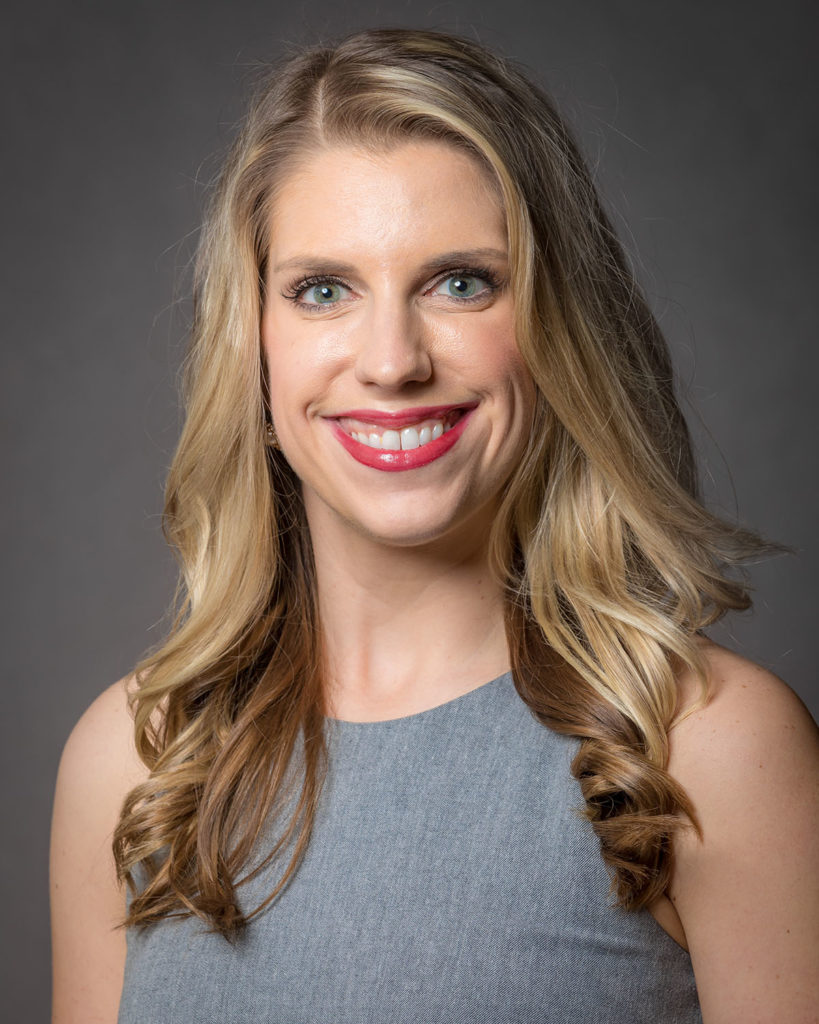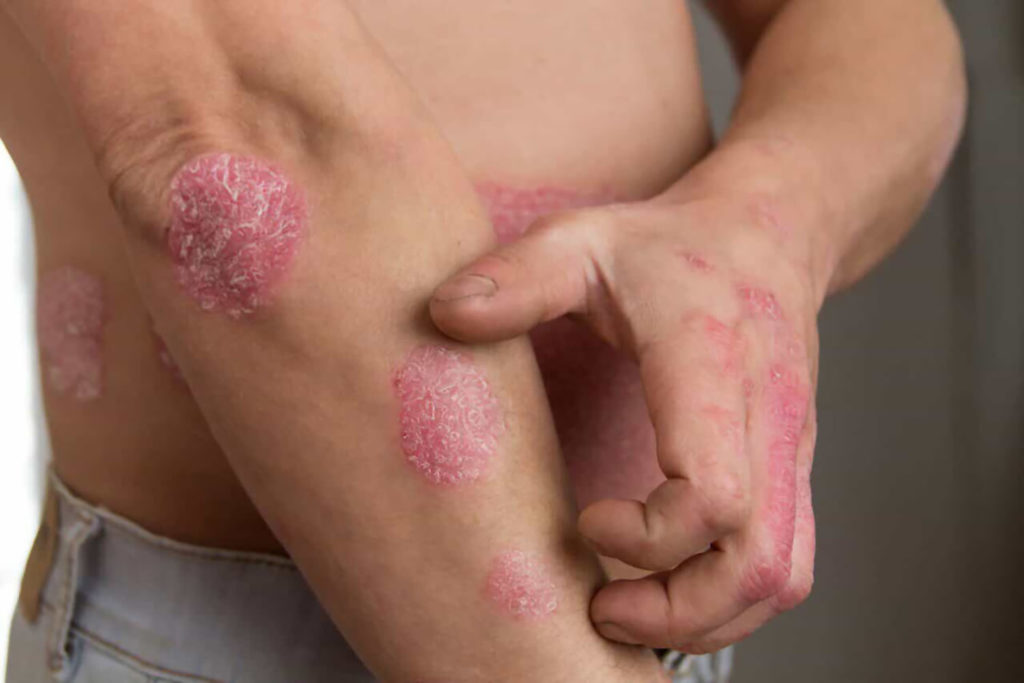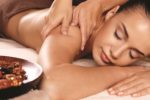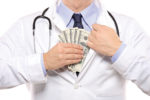Psoriasis

WHAT YOU NEED TO KNOW ABOUT THIS COMMON SKIN CONDITION
If you or a loved one has psoriasis, you know it can be a frustrating, sometimes embarrassing condition. The characteristic areas of thick, red, scaly skin may respond to topical agents, but some cases require other forms of therapy. Dr. Emilie Badje, a board certified dermatologist of Dermatology Consultants Midwest in Overland Park gave us some insight on this condition.

Psoriasis typically causes patches of itchy, scaly and sometimes inflamed skin. Although they can appear anywhere, these patches, called plaques, are most likely to crop up on your knees, elbows, hands, feet, scalp or back. In about 50% of all cases, the fingernails and toenails are also affected.
The symptoms of psoriasis can vary a great deal depending on its severity, ranging from mildly annoying to truly debilitating.
While the itchiness and pain can be unpleasant to say the least, some of the worst effects can be emotional. People with severe psoriasis sometimes are so overwhelmed by their condition and self-conscious of their appearance that they feel isolated and depressed.
Researchers estimate that up to seven million people in the U.S. have psoriasis, about 1% to 2% of the population. Unfortunately, there isn’t a cure for this condition, but there are a number of effective treatments that can help keep it under control.
WHAT CAUSES PSORIASIS?
Psoriasis is a common inflammatory disease of the skin, resulting from genetic predisposition combined with environmental triggers including trauma, infection, stress and medications. “Typical prevalence is around 2% of the world’s population, however in the U.S. and Canada prevalence is as high as 4.7%. Around 75% of patients will have mild disease while around 25% will have more severe involvement. Psoriasis can appear at any age, from infancy to the eighth decade of life. The disease has two peaks of onset, one at age 20-30 years and a second at 50-60 years. In 75% of patients onset is before age 40, and in 35-50% before age 20. There are multiple genes which contribute to the development of psoriasis, and between 35-90% of patients with the disease will have a positive family history,” explained Dr. Badje.
Normally, skin cells are constantly being formed, then pushed up to the surface where they eventually die and flake off, revealing new skin cells. In people with psoriasis, however, the skin cells grow too quickly, causing layers of skin to build up, forming a whitish, flaky crust. Blood vessels increase flow in an attempt to nourish this skin, causing reddened inflammation. Thus the hallmark symptoms are reddened, inflamed skin with a whitish, flaky layer of dead cells on top.
Although psoriasis usually appears as a skin condition, recent discoveries show that its real cause is a problem with the immune system.
Your body naturally fights infections and heals injuries with special cells — called white blood cells — that are designed to battle viruses or bacteria. Normally these cells go to the site of infection or injury and release antibodies and other chemicals to repair wounds, clot blood and prevent infection. One byproduct of this normal process is inflammation (redness and swelling).

TYPES OF PSORIASIS
“Psoriasis is characterized by sharply demarcated, scaly red to salmon colored plaques with overlying silvery scale. The most common sites of involvement are the scalp, gluteal fold, elbows and knees, followed by the nails, hands, feet and trunk. This describes the most common type of psoriasis, chronic plaque type. Other variants include guttate psoriasis, pustular psoriasis and psoriasis limited to special locations, such as the scalp, flexural sites or nails,” Dr Badje stated.
“Arthritis is the major associated systemic finding, typically presenting asymmetrically in a few small joints such as the hands and feet. Psoriatic arthritis affects 5-30% of patients with cutaneous psoriasis. Early diagnosis of psoriatic arthritis is key to preventing progression of joint symptoms, which can result in loss of function and irreversible damage,” said Dr. Badje.
Other comorbidities of psoriasis include depression, metabolic syndrome and cardiovascular disease. There are several different types of psoriasis. About 90% of all cases of psoriasis are plaque psoriasis, but other varieties include:
Guttate Psoriasis: This form of psoriasis usually affects children, teenagers, and young adults. It often appears after a bacterial infection, such as strep throat. Its typical symptoms are the appearance of red, scaly, raindrop-shaped spots on the skin, usually over the abdomen, arms, legs and scalp. It can often clear up on its own without treatment.
Pustular Psoriasis: The typical symptoms of pustular psoriasis are pus-filled blisters on the skin. The blisters usually dry up, turn brown, become scaly and peel off. The lesions usually occur on the hands and feet.
Erythrodermic Psoriasis: Symptoms include red and scaly skin over large areas of the body. This condition can evolve from other forms of psoriasis or be triggered by psoriasis treatment. It can also be triggered by withdrawal from drugs such as corticosteroids (often taken for diseases such as asthma).
Inverse Psoriasis: In people with this condition, dry and bright red patches appear in folds of skin, for instance under the breasts, in the armpits, or on the genitals. This type of psoriasis can be exacerbated by obesity.

TYPES OF THERAPY AVAILABLE
“There are a spectrum of treatments available. Mild disease is usually treated with topical steroids and vitamin D derivatives. Other topical therapies include tar based creams, anthralin, calcineurin inhibitors and tazarotene. In widespread disease options such as phototherapy, Methotrexate, Cyclosporine, or targeted immunomodulator (biologic) therapies are available. These newer biologic medications are highly specific and target specific pathways in the immune system which drive the inflammatory response leading to psoriatic lesions. Management requires individualization of therapy, with consideration of the extent of disease and its effect on the patient’s quality of life, as well as the likely benefits and potential side effects of specific therapies. Psoriasis is a chronic disease which necessitates a long-term approach to therapy,” Dr Badje stated.

STAYING ONE STEP AHEAD WITH APPS
If you’re looking for ways to connect with others who are dealing with the condition or track the progress of your symptoms over time, believe it or not – THERE’S AN APP FOR THAT!
Flaym: Created by the LEO Innovation Lab, this user-friendly app is a social media platform for people living with psoriasis. In addition to providing an easier way to connect with others dealing with the condition, it provides groups based on topic (parenting, diet, exercise, travel) and offers tools to help host meetups.
Imagine: This app allows you to document and track how your psoriasis develops over time by using your phone’s camera. The split-screen feature enables you to compare your condition over time and relate it to the effectiveness of your treatment with your dermatologist.
There are several different ways to track and treat your psoriasis. Make sure to speak with your physician and see what is right for you.
For more information on Dr. Emilie Badje and Dermatology Consultants Midwest, call 913.469.0110 or visit dermcomw.com
Sources: WebMD, Dermatology Consultants Midwest, Everyday Health.






